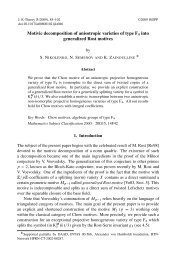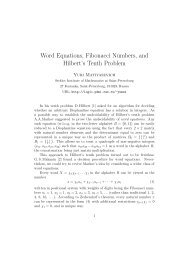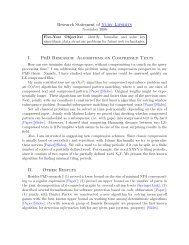TROPICAL CRYPTOGRAPHY Mathematics subject classification ...
TROPICAL CRYPTOGRAPHY Mathematics subject classification ...
TROPICAL CRYPTOGRAPHY Mathematics subject classification ...
Create successful ePaper yourself
Turn your PDF publications into a flip-book with our unique Google optimized e-Paper software.
<strong>TROPICAL</strong> <strong>CRYPTOGRAPHY</strong>DIMA GRIGORIEV AND VLADIMIR SHPILRAINAbstract. We employ tropical algebras as platforms for several cryptographicschemes that would be vulnerable to linear algebra attacks were they based on “usual”algebras as platforms.Keywords: tropical algebra, public key exchange, encryption<strong>Mathematics</strong> <strong>subject</strong> <strong>classification</strong>: 15A80, 94A60.1. IntroductionIn this paper, we employ tropical algebras as platforms for several cryptographicschemes. The schemes themselves are not brand new; similar ideas were used in the“classical” case, i.e., for algebras with the familiar addition and multiplication. However,in the classical case these schemes were shown to be vulnerable to various linearalgebra attacks. Here we make a case for using tropical algebras as platforms by using,among other things, the fact that in the “tropical” case, even solving systems of linearequations is computationally infeasible in general. Yet another advantage is improvedefficiency because in tropical schemes, one does not have to perform any multiplicationsof numbers since tropical multiplication is the usual addition, see below.We start by giving some necessary information on tropical algebras here; for moredetails, we refer the reader to a recent monograph [2].Consider a tropical semiring S (also known as the min-plus algebra due to the followingdefinition). This semiring is defined as a subset of reals that contains 0 and isclosed under addition, with two operations as follows:x ⊕ y = min(x, y)x ⊗ y = x + y.It is straightforward to see that these operations satisfy the following properties:associativity:x ⊕ (y ⊕ z) = (x ⊕ y) ⊕ zx ⊗ (y ⊗ z) = (x ⊗ y) ⊗ z.Research of the first author was partially supported by the Federal Agency of the Science andInnovations of Russia, State Contract No. 02.740.11.5192.Research of the second author was partially supported by the NSF grants DMS-0914778 and CNS-1117675.1
2 <strong>TROPICAL</strong> <strong>CRYPTOGRAPHY</strong>commutativity:x ⊕ y = y ⊕ xx ⊗ y = y ⊗ x.distributivity:(x ⊕ y) ⊗ z = (x ⊗ z) ⊕ (y ⊗ z).There are some “counterintuitive” properties as well:x ⊕ x = xx ⊗ 0 = xx ⊕ 0 could be either 0 or x.There is also a special “ɛ-element” ɛ = ∞ such that, for any x ∈ S,ɛ ⊕ x = xɛ ⊗ x = ɛ.A (tropical) monomial in S looks like a usual linear function, and a tropical polynomialis the minimum of a finite number of such functions, and therefore a concave,piecewise linear function. The rules for the order in which tropical operations areperformed are the same as in the classical case, see the example below.Example 1. Here is an example of a tropical monomial: x⊗x⊗y⊗z⊗z. The (tropical)degree of this monomial is 5. We note that sometimes, people use the alternativenotation x ⊗2 for x ⊗ x, etc.An example of a tropical polynomial is: p(x, y, z) = 5⊗x⊗y ⊗z ⊕x⊗x⊕2⊗z ⊕17 =(5 ⊗ x ⊗ y ⊗ z) ⊕ (x ⊗ x) ⊕ (2 ⊗ z) ⊕ 17. This polynomial has (tropical) degree 3, by thehighest degree of its monomials.We note that, just as in the classical case, a tropical polynomial is canonically representedby an ordered set of tropical monomials (together with non-zero coefficients),where the order that we use here is deglex.While the ⊕ operation is obviously not invertible, the ⊗ operation is, and we denotethe inverse of this operation by ⊘ (it is just the classical subtraction):x ⊘ y = z if and only if y ⊗ z = x.We refer to [8] for more detailed properties of this operation; here we just mentionthe following properties that agree with those of the usual division:(x ⊘ y) ⊗ (z ⊘ t) = (x ⊗ z) ⊘ (y ⊗ t)(x ⊘ y) ⊕ (z ⊘ t) = ((x ⊗ t) ⊕ (y ⊗ z)) ⊘ (y ⊗ t).Also as in the classical case, there is an equivalence relation on the set of all expressionsof the form x ⊘ y:x ⊘ y is equivalent to z ⊘ t if and only if x ⊗ t = y ⊗ z.All expressions of the form x ⊘ y, where x, y ∈ S, modulo the above equivalence,form a semifield (of quotients of S), which we denote by Rat(S), see [8].
<strong>TROPICAL</strong> <strong>CRYPTOGRAPHY</strong> 31.1. Tropical matrix algebra. A tropical algebra can be used for matrix operationsas well. To perform the A ⊕ B operation, the elements m ij of the resulting matrixM are set to be equal to a ij ⊕ b ij . The ⊗ operation is similar to the usual matrixmultiplication, however, every “+” calculation has to be substituted by a ⊕ operation,and every “·” calculation by a ⊗ operation.Example 2.Example 3.(1 25 −1(1 25 −1)⊕)⊗( ) (0 3 0 2=2 8 2 −1( ) (0 3 1 4=2 8 1 7The role of the identity matrix I is played by the matrix that has “0”s on the diagonaland ∞ elsewhere. Similarly, a scalar matrix would be a matrix with an element λ ∈ S onthe diagonal and ∞ elsewhere. Such a matrix commutes with any other square matrix(of the same size). Multiplying a square matrix by a scalar amounts to multiplying itby the corresponding scalar matrix.( ) ( ) ( ) ( )1 2 2 ∞ 1 2 3 4Example 4. 2 ⊗=⊗= .5 −1 ∞ 2 5 −1 7 1Then, tropical diagonal matrices have something on the diagonal and ∞ elsewhere.We also note that, in contrast with the “classical” situation, it is rather rare thata “tropical” matrix is invertible. More specifically (see [2, p.5]), the only invertibletropical matrices are those that are obtained from a diagonal matrix by permutingrows and/or columns.2. Key exchange using matrices over a tropical algebraWe are now going to offer a key exchange protocol building on an idea of Stickel [13]who used it for matrices over “usual” algebras, which made his scheme vulnerable tolinear algebra attacks, see e.g. [11]. Since we believe that Stickel’s idea itself has agood potential, we suggest here to use matrices over a tropical algebra as the platformfor his scheme, in order to prevent linear algebra attacks.We start by recalling the original Stickel’s protocol. Let G be a public noncommutativesemigroup, a, b ∈ G public elements such that ab ≠ ba. The key exchangeprotocol goes as follows.2.1. Protocol 1 [13].(1) Alice picks two random natural numbers n, m and sends u = a n b m to Bob.(2) Bob picks two random natural numbers r, s and sends v = a r b s to Alice.(3) Alice computes K A = a n vb m = a n+r b m+s .(4) Bob computes K B = a r ub s = a n+r b m+s .Thus, Alice and Bob end up with the same group element K = K A = K B which canserve as the shared secret key.This can be generalized if the platform is not just a semigroup, but a ring (actually,a semiring would suffice):).).
4 <strong>TROPICAL</strong> <strong>CRYPTOGRAPHY</strong>2.2. Protocol 2 [6, 11]. Let R be a public non-commutative ring (or a semiring),a, b ∈ R public elements such that ab ≠ ba.(1) Alice picks two random polynomials p 1 (x), p 2 (x) (say, with positive integer coefficients)and sends p 1 (a) · p 2 (b) to Bob.(2) Bob picks two random polynomials q 1 (x), q 2 (x) and sends q 1 (a) · q 2 (b) to Alice.(3) Alice computes K A = p 1 (a) · (q 1 (a) · q 2 (b)) · p 2 (b).(4) Bob computes K B = q 1 (a) · (p 1 (a) · p 2 (b)) · q 2 (b).Thus, since p 1 (a) · q 1 (a) = q 1 (a) · p 1 (a) and p 2 (b) · q 2 (b) = q 2 (b) · p 2 (b), Alice and Bobend up with the same element K = K A = K B which can serve as the shared secret key.It is Protocol 2 that we propose to adopt in the “tropical” situation.2.3. Protocol 3 (tropical). Let R be the tropical algebra of n × n matrices overintegers, and let A, B ∈ R be public matrices such that A ⊗ B ≠ B ⊗ A.(1) Alice picks two random tropical polynomials p 1 (x), p 2 (x) (with integer coefficients)and sends p 1 (A) ⊗ p 2 (B) to Bob.(2) Bob picks two random tropical polynomials q 1 (x), q 2 (x) and sends q 1 (A)⊗q 2 (B)to Alice.(3) Alice computes K A = p 1 (A) ⊗ (q 1 (A) ⊗ q 2 (B)) ⊗ p 2 (B).(4) Bob computes K B = q 1 (A) ⊗ (p 1 (A) ⊗ p 2 (B)) ⊗ q 2 (B).Thus, since p 1 (A)⊗q 1 (A) = q 1 (A)⊗p 1 (A) and p 2 (B)⊗q 2 (B) = q 2 (B)⊗p 2 (B), Aliceand Bob end up with the same element K = K A = K B which can serve as the sharedsecret key.2.4. What are the advantages of the “tropical” Protocol 3 over “classical”Protocols 1 and 2? One obvious advantage is improved efficiency because when multiplyingmatrices in the tropical sense, one does not have to perform any multiplicationsof numbers since tropical multiplication is the “usual” addition.To compare security, we briefly recall a linear algebra attack [11] on Stickel’s originalprotocol (Protocol 1), where G was a group of invertible matrices over a field. In thatcase, to recover a shared key K, it is not necessary to find the exponents n, m, r, ors. Instead, as was shown in [11], it is sufficient for the adversary to find matrices xand y such that xa = ax, yb = by, and xu = y. (Here x corresponds to a −n , while ycorresponds to b m .)These conditions translate into a system of 3k 2 linear equations with 2k 2 unknowns,where k is the size of the matrices. This typically yields a unique solution (accordingto computer experiments of [11] and [10]), which can be efficiently found if the matricesare considered over a field.We note that in [10], a more sophisticated attack on a more general Protocol 2 wasoffered. This attack applies to not necessarily invertible matrices over a field.In the “tropical” situation (Protocol 3), however, a linear algebra attack will notwork, for several reasons:
<strong>TROPICAL</strong> <strong>CRYPTOGRAPHY</strong> 5(1) Matrices are generically not invertible, so the equation XY = U with known Uand unknown X, Y does not translate into a system of linear equations.(2) The equations XA = AX, Y B = BY do translate into a system of linearequations, which may be called a “two-sided min-linear system”, following [2].In [1], it is shown that the problem of solving such systems is in the classNP ∩ Co − NP (there is a belief that it does not belong to the class P). Werefer to [2] for a comprehensive exposition of what is known concerning existingalgorithms for solving two-sided min-linear systems and their complexity. Herewe just say that, while it is known how to find one of the solutions of a system(if a solution exists), there is no known efficient method for describing the linearspace of all solutions, in contrast with the “classical” situation.2.5. Parameters and key generation. Here we suggest values of the parametersinvolved in the description of our Protocol 3.• The size of matrices n = 10.• The entries of the public matrices A, B are integers, selected uniformly randomlyin the range [−10 10 , 10 10 ].• The degrees of the tropical polynomials p 1 (x), p 2 (x), q 1 (x), q 2 (x) are selecteduniformly randomly in the range [1, 10].• The coefficients of the above tropical polynomials are selected uniformly randomlyin the range [−1000, 1000].With these parameters, the size of the key space (for private tropical polynomials)is approximately 10 30 .3. Encryption using birational automorphisms of a tropical polynomialalgebraIn this section, we describe a public key encryption scheme that would be susceptibleto a linear algebra attack in the “classical” case (cf. [9], [4]), but not in the “tropical”case.Let P = Rat[x 1 , . . . , x n ] be the quotient semifield of a tropical polynomial algebraover Z.3.1. The protocol. There is a public automorphism α ∈ Aut(P ) given as a tuple oftropical rational functions (α(x 1 ), . . . , α(x n )). Alice’s private key is α −1 . Note that αis also a bijection of the set Z n , i.e., it is a one-to-one map of the set of all n-tuples ofintegers onto itself. We will use the same notation α for an automorphism of P and forthe corresponding bijection of Z n , hoping this will not cause a confusion.(1) Bob’s secret message is a tuple of integers s = (s 1 , . . . , s n ) ∈ Z n . Bob encryptshis tuple by applying the public automorphism α: E α (s) = α(s 1 , . . . , s n ).(2) Alice decrypts by applying her private α −1 to the tuple E α (s): α −1 (E α (s)) =s = (s 1 , . . . , s n ).
6 <strong>TROPICAL</strong> <strong>CRYPTOGRAPHY</strong>3.2. Key generation. The crucial ingredient in this scheme is, of course, generatingthe public key α ∈ Aut(P ). Alice can generate her automorphism α as a productof “monomial” automorphisms on the set of variables {x 1 , . . . , x n } and “triangular”automorphisms of the formϕ : x i → x i ⊗ p i (x i+1 , . . . , x n ), 1 ≤ i ≤ n,where p i ∈ P = Rat[x 1 , . . . , x n ]. Each triangular automorphism, in turn, is a productof “elementary” triangular automorphisms; these are of the formThe inverse of such a τ isτ : x j → x j ⊗ q j (x j+1 , . . . , x n ), x k → x k , k ≠ j.τ −1 : x j → x j ⊘ (q j (x j+1 , . . . , x n )), x k → x k , k ≠ j,where q j ∈ P .“Monomial” automorphisms are analogs of linear automorphisms in the “classical”situation; they are of the formµ : x i → b i ⊗ x ⊗a i11 ⊗ · · · ⊗ x ⊗a inwhere b i are finite coefficients (i.e., b i ≠ ∞), and the matrix A = (a ij ) of integerexponents is invertible in the “classical” sense.We note, in passing, that a question of independent interest (independent of cryptographicapplications) is:n ,Problem 1. Is every automorphism of P = Rat[x 1 , . . . , x n ], the quotient semifield ofa tropical polynomial algebra over Z, a product of triangular and monomial automorphisms?3.3. Parameters. We suggest the following parameters.• The number n of variables in the platform tropical polynomial algebra: 10.• The number of triangular automorphisms in a product for α: 2. The numberof monomial automorphisms: 3. More specifically, Alice generates her α in thefollowing form:α = µ 1 ◦ ϕ 1 ◦ µ 2 ◦ ϕ 2 ◦ µ 3 ,where ϕ 1 , ϕ 2 are triangular automorphisms, and µ 1 , µ 2 , µ 3 are monomial automorphisms.• The tropical degrees of all q j are equal to 2.• The coefficients of the above tropical polynomials q j are selected uniformlyrandomly in the range [−10, 10].Remark 1. Alice can obtain the inverse of α as the product of inverses of the automorphismsϕ i and µ i , in the reverse order. However, Alice does not have to computean explicit expression for α −1 ; this computation may not be efficient since the degreeof α −1 may be substantially greater than the degree of α. In our protocol, Alice has to
<strong>TROPICAL</strong> <strong>CRYPTOGRAPHY</strong> 7apply α −1 to a particular point in Z n ; efficient way of doing this is to first apply µ −1then apply ϕ −12 to the obtained point, etc.Remark 2. There is a ramification of the above protocol, where Bob’s secret message isa tropical polynomial u, instead of a point in Z n . (Note that the result of encrypting uwill be, in general, an element of P = Rat[x 1 , . . . , x n ].) In this ramification, decryptionis going to have a much higher computational complexity because Alice would haveto compute an explicit expression for α −1 (cf. the previous remark). On the otherhand, encryption in this case is going to be homomorphic (in the “tropical” sense)because α(u 1 ⊕ u 2 ) = α(u 1 ) ⊕ α(u 2 ) and α(u 1 ⊗ u 2 ) = α(u 1 ) ⊗ α(u 2 ). For examples ofhomomorphic encryption in the “classical” case see e.g. [5] or [7].Remark 3. One can consider an encryption protocol, similar to the one above, also inthe “classical” case. As we have already pointed out, polynomial automorphisms wereemployed in a similar context in [9], but birational automorphisms have not been usedfor cryptographic purposes before, to the best of our knowledge.3.4. Possible attacks. There are the following two attacks that adversary may attempt.(1) Trying to compute α −1 from the public automorphism α. The problem withthis attack is that the degree of α −1 may be exponentially greater than thedegree of α, which makes any commonly used attack (e.g. a linear algebraattack) infeasible.(2) Trying to recover Bob’s secret message s from α(s). This translates into asystem of tropical polynomial equations; solving such a system is an NP-hardproblem, as we show in the following proposition.Proposition 1. The problem of solving systems of tropical polynomial equations isNP-hard.Before getting to the proof, we note that for a closely related, but different, problemof emptiness of a tropical variety NP-completeness was established in [14].Proof. We show how to reduce the SAT problem to the problem of solving a systemof tropical polynomial equations. Recall that the SAT (for SATisfiability) problem isa decision problem, whose instance is a Boolean expression written using only AND,OR, NOT, variables, and parentheses. The question is: given the expression, is theresome assignment of TRUE (=1) and FALSE (=0) values to the variables that will makethe entire expression true? A formula of propositional logic is said to be satisfiable iflogical values can be assigned to its variables in a way that makes the formula true. TheBoolean satisfiability problem is NP-complete [3]. The problem remains NP-completeeven if all expressions are written in conjunctive normal form with 3 variables per clause(3-CNF), yielding the 3-SAT problem.Suppose now we have a 3-CNF, and we are going to build (in time polynomial inthe number of clauses) a system of tropical polynomial equations that has a solutionif and only if the given 3-CNF is satisfiable. Denote Boolean variables in the given3-CNF by u i . In our tropical system, we are going to have two kinds of variables: those3 ,
8 <strong>TROPICAL</strong> <strong>CRYPTOGRAPHY</strong>corresponding to literals u i will be denoted by x i , and those corresponding to literals¬u i will be denoted by y i .First of all, we include in our tropical system all equations of the form x i ⊗y i = 1, forall i.Now suppose we have a clause with 3 literals, for example, u i ∨ ¬u j ∨ ¬u k . To thisclause, we correspond the following tropical polynomial equation:y i ⊕ x j ⊕ x k = 0.Obviously, the above clause is TRUE if and only if either u i = 1, or u j = 0, or u k = 0.If u i = 1, then y i = 0, and our tropical equation is satisfied. If, say, u j = 1, thenx j = 0, and again our tropical equation is satisfied. This shows that if a given 3-CNFis satisfiable, then our tropical equation has a solution.If, on the other hand, our tropical equation has a solution, that means either y i = 0,or x j = 0, or x k = 0. In any case, the given clause is easily seen to be TRUE uponcorresponding u i to x i and ¬u i to y i . (Note that if, say, y i = 0, then, since we alsohave the equation x i ⊗ y i = 1, x i should be equal to 1.)Having thus built a tropical equation for each clause in the given 3-CNF, we end upwith a system of tropical polynomial equations that corresponds to the whole 3-CNF,which is solvable if and only if the given 3-CNF is satisfiable. This completes the proof.□Acknowledgement. Both authors are grateful to Max Planck Institut für Mathematik,Bonn for its hospitality during the work on this paper.References[1] M. Bezem, R. Nieuwenhuis, E. Rodrguez-Carbonell, Hard problems in maxalgebra, control theory,hypergraphs and other areas, Information Processing Letters 110(4) (2010), 133-138.[2] P. Butkovic, Max-linear systems: theory and algorithms, Springer-Verlag London, 2010.[3] M. Garey, J. Johnson, Computers and Intractability, A Guide to NP-Completeness, W. H.Freeman, 1979.[4] L. Goubin, N. Courtois, Cryptanalysis of the TTM cryptosystem, in: ASIACRYPT 2000, LectureNotes in Comput. Sci. 1976 (2000), 44-57.[5] D. Grigoriev, I. Ponomarenko, Constructions in public-key cryptography over matrix groups,Contemp. Math., Amer. Math. Soc. 418 (2006), 103–119.[6] G. Maze, C. Monico, J. Rosenthal, Public key cryptography based on semigroup actions, Advancesin <strong>Mathematics</strong> of Communications 4 (2007), 489-507.[7] A. Menezes, P. van Oorschot, and S. Vanstone, Handbook of Applied Cryptography, CRC-Press1996.[8] G. Mikhalkin, Tropical geometry, in preparation.http://www.math.toronto.edu/mikha/book.pdf[9] T. Moh, A public key system with signature and master key functions, Comm. Algebra 27(1999), 2207-2222.[10] C. Mullan, Cryptanalysing variants of Stickel’s key agreement scheme, preprint.[11] V. Shpilrain, Cryptanalysis of Stickel’s key exchange scheme, in: Computer Science in Russia2008, Lecture Notes Comp. Sc. 5010 (2008), 283-288.
<strong>TROPICAL</strong> <strong>CRYPTOGRAPHY</strong> 9[12] R. Steinwandt and A. Suárez Corona, Cryptanalysis of a 2-party key establishment based on asemigroup action problem, Advances in <strong>Mathematics</strong> of Communications 5 (2011), 87–92.[13] E. Stickel, A New Method for Exchanging Secret Keys. In: Proc. of the Third InternationalConference on Information Technology and Applications (ICITA05) 2 (2005), 426–430.[14] T. Theobald, On the frontiers of polynomial computations in tropical geometry, J. SymbolicComput. 41 (2006), 1360–1375.CNRS, Mathématiques, Université de Lille, 59655, Villeneuve d’Ascq, FranceE-mail address: dmitry.grigoryev@math.univ-lille1.frDepartment of <strong>Mathematics</strong>, The City College of New York, New York, NY 10031E-mail address: shpil@groups.sci.ccny.cuny.edu











